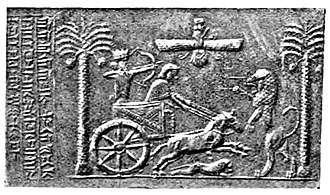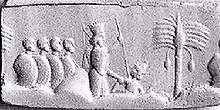Persian king and the defeated enemies
The scene of a Persian king and the defeated enemies is depicted on an Achaemenid cylinder seal made from chalcedony, and housed in the Hermitage Museum of Saint Petersburg, Russia (inv.no. Гл-501) since 1930, when it was acquired from a private collection.[2] It is the so-called "Zvenigorodsky seal", it was acquired in Kertch,[3] and first appears in the 1881 Compte rendu de la Commission Impériale Archéologique pour l'Année 1881.[4]
| Persian king and the defeated enemies (Zvenigorodsky seal) | |
|---|---|
 Photograph of the seal (top), and drawing by Faucher-Gudin of the cylinder’s impression (bottom).[1] | |
_(14584087089).jpg) | |
| Material | Chalcedony |
| Size | 2.8 cm (1.1 in) x 1.2 cm (0.47 in) |
| Created | Late 5th–early 4th century BCE |
| Present location | Hermitage Museum |
| Identification | Гл-501 |
Content
The cylinder depicts an Achaemenid King of Kings holding a kneeling captive with a hand, and subjugating him with a spear held by the other hand. The kneeling captive wears an Egyptian crown.[3] Behind the king there are four prisoners with a rope around their necks, the rope being held by the king himself. Their garment is similar to that of the Egyptians seen on the reliefs of Naqsh-e Rostam.[5] The scene therefore refers to Egypt, and to an act of conquest or the suppression of a rebellion by an Achaemenid king.[3] It is generally thought that the seal depicts a Persian king or hero thrusting his lance at an Egyptian pharaoh, while holding four other Egyptian captives on a rope.[6][7][8]
A rather similar seal is known bearing the inscription "I am Artaxerxes the Great King" in cuneiform (the "Moscow Artaxerxes Cylinder Seal"):[9][10] the Achaemenid king is shown leading the Egyptian captives on a rope, but the kneeling figure of the Pharaoh is absent and replaced by the Old Persian cuneiform inscription.[5][11] The inscription would suggest that the king in the seal is either Artaxerxes III, who reconquered Egypt, or more probably Artaxerxes I (r. 465-424 BC), who did put down a rebellion in Egypt,[5][12] given the rather rigid execution of the engraving, which suggests an early date for its manufacture, probably closer to the time of Darius I.[5]

The seal has many similarities with the seal of Darius I (c. 550–486 BC), both in the rather rigid treatment of the figures, and in the composition of the seal itself.[5] On these grounds, the manufacture of the Zvenigorodsky seal could be attributed to a period rather close to that of Darius I, which would favour an attribution to Artaxerxes I.[5]
Identification
All the characters on the cylinder are unnamed, thus making difficult to identify at least the two main figures. The Hermitage Museum indeed does not give any identification, yet it dates the seal to the late 5th–early 4th century BCE.[2]
Nevertheless, several attempts to identify at least the Achaemenid ruler were made. In 1903, Gaston Maspero suggested that the scene depicts Darius the Great dealing with some rebels.[1] In 1979, Muhammad Dandamayev opted for Artaxerxes II.[13] In 1992, Shapur Shahbazi suggested without certainty that the ruler could have been "Artaxerxes (III?)".[14]

An almost identical scene appears on another chalcedony cylinder, held by the Metropolitan Museum of Art (Acc. No. 1999.325.114), but with an earlier dating (6th–5th century BCE). Also in this case, there are no inscriptions that could help in identifying the characters.[16]
References
- Maspero, Gaston (1903). History of Egypt, Chaldea, Syria, Babylonia and Assyria. 9. London: The Grolier Society., p. 166
- Cylindrical seal. Persian King and the Defeated Enemies. Hermitage Museum
- Strelkov, Alexander S. (1937). "THE MOSCOW ARTAXERXES CYLINDER SEAL". Bulletin of the American Institute for Iranian Art and Archaeology. 5 (1): 17–21. JSTOR 44243379.
- Compte rendu de la Commission Impériale Archéologique pour l'Année 1881. 1881. pp. Plate V.
- Strelkov, Alexander S. (1937). "THE MOSCOW ARTAXERXES CYLINDER SEAL". Bulletin of the American Institute for Iranian Art and Archaeology. 5 (1): 17–21. JSTOR 44243379.
- "a Persian hero slaughtering an Egyptian pharaoh while leading four other Egyptian captives" Hartley, Charles W.; Yazicioğlu, G. Bike; Smith, Adam T. (2012). The Archaeology of Power and Politics in Eurasia: Regimes and Revolutions. Cambridge University Press. p. ix, photograph 4.6. ISBN 9781139789387.
- "Victor, apparently wearing the tall Persian headdress rather than a crown, leads four bareheaded Egyptian captives by a rope tied to his belt. Victor spears a figure wearing Egyptian type crown." in Root, Margaret Cool (1979). The king and kingship in Achaemenid art: essays on the creation of an iconography of empire. Diffusion, E.J. Brill. p. 182. ISBN 9789004039025.
- "Another seal, also from Egypt, shows a Persian king, his left hand grasping an Egyptian with an Egyptian hairdo (pschent), whom he thrusts through with his lance while holding four prisoners with a rope around their necks." Briant, Pierre (2002). From Cyrus to Alexander: A History of the Persian Empire. Eisenbrauns. p. 215. ISBN 9781575061207.
- "Moscow Artaxerxes Seal". Pushkin Museum.
- Strelkov, Alexander S. (1937). "THE MOSCOW ARTAXERXES CYLINDER SEAL". Bulletin of the American Institute for Iranian Art and Archaeology. 5 (1): 17–21. ISSN 2573-6167.
- Root, Margaret Cool; Frye, Richard N. The King and Kingship in Achaemenid Art. Essays on the Creation of an Iconography of Empire. p. 122 Note 15.
- Martin, Richard A. (Richard Arthur) (1940). Ancient seals of the Near East. Chicago: Field Museum Press. p. No. 17.
- Dandamayev, M.A. (1979). Persien unter den ersten Achämeniden (6. Jahrhundert v. Chr.). Wiesbaden: Dr. Ludwig Reichert Verlag., pl. XV
- Shahbazi, Shapur (1992). "Clothing II. In the Median and Achaemenid periods", in Encyclopædia Iranica, pl. LV
- Ancient Seals of the Near East, plaque 17
- Cylinder seal and modern impression: battle scene with king, soldiers, enemy,ca. 6th–5th century B.C.. The Met
Bibliography
| Wikimedia Commons has media related to Persian king and the defeated enemies. |
- Root, Margaret Cool; Frye, Richard N. (1979). The King and Kingship in Achaemenid Art. Essays on the Creation of an Iconography of Empire.
- Strelkov, Alexander S. (1937). "THE MOSCOW ARTAXERXES CYLINDER SEAL". Bulletin of the American Institute for Iranian Art and Archaeology. 5 (1): 17–21. JSTOR 44243379.
